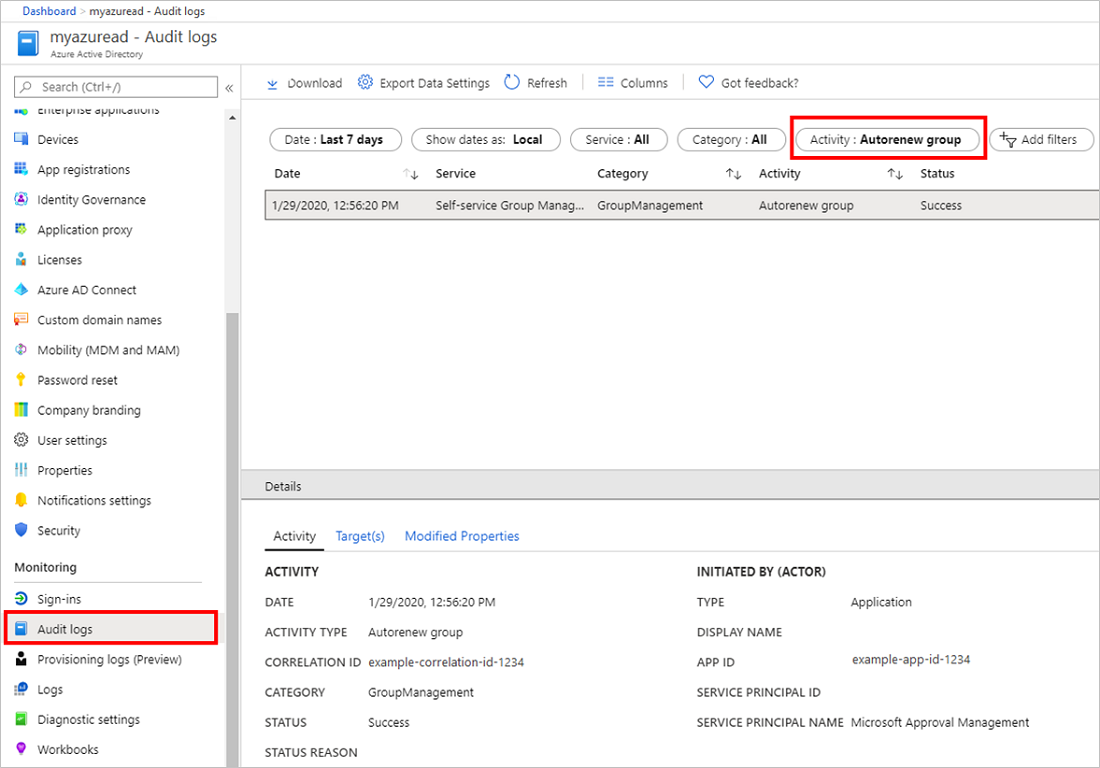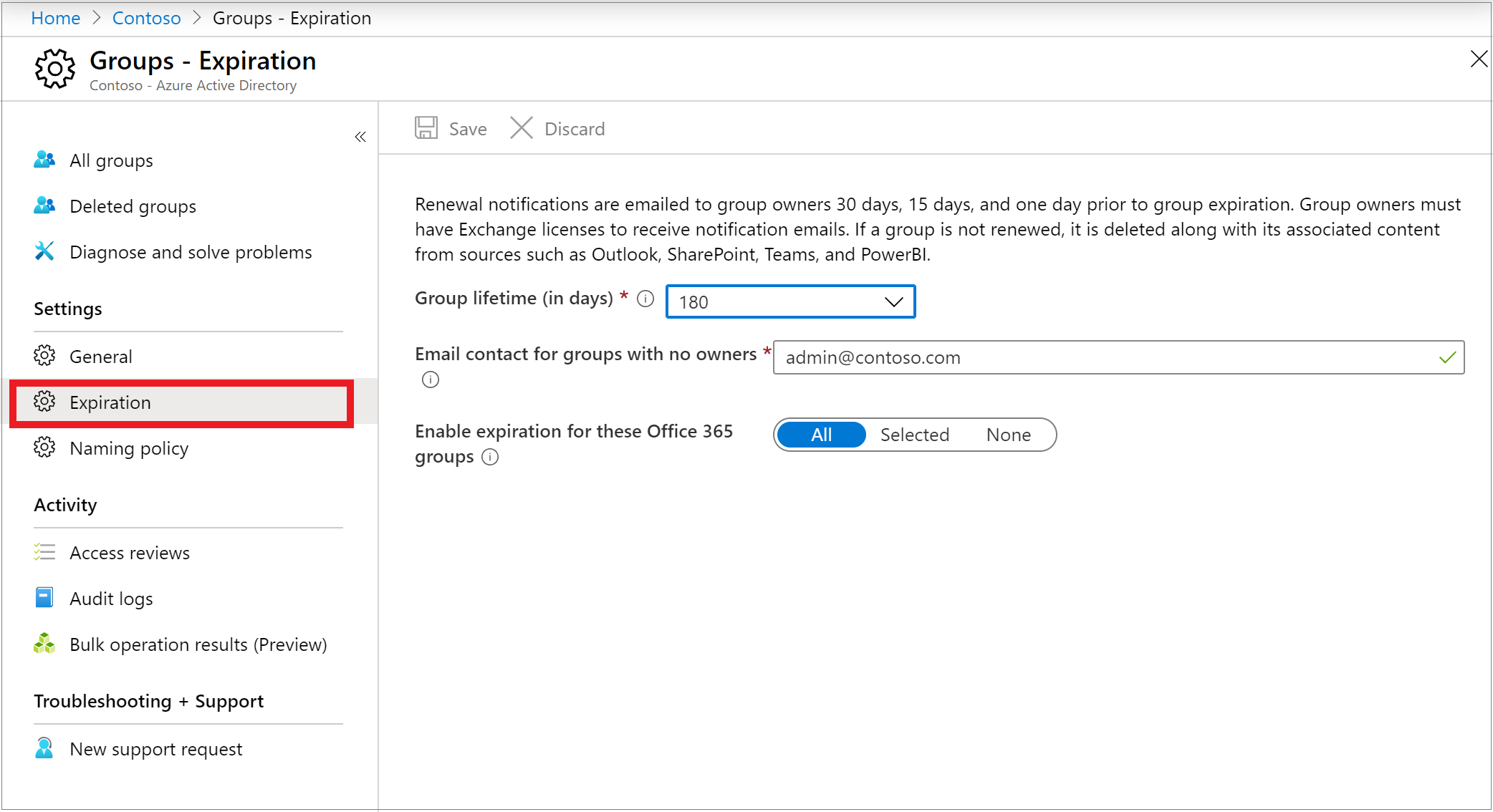Events
Apr 9, 3 PM - Apr 10, 12 PM
Code the Future with AI and connect with Java peers and experts at JDConf 2025.
Register NowThis browser is no longer supported.
Upgrade to Microsoft Edge to take advantage of the latest features, security updates, and technical support.
This article tells you how to manage the lifecycle of Microsoft 365 groups by setting an expiration policy for them. You can set an expiration policy only for Microsoft 365 groups in Microsoft Entra ID.
After you set a group to expire:
Currently, you can configure only one expiration policy for all Microsoft 365 groups in a Microsoft Entra organization.
Note
Configuring and using the expiration policy for Microsoft 365 groups requires you to possess but not necessarily assign Microsoft Entra ID P1 or P2 licenses for the members of all groups to which the expiration policy is applied.
For information on how to download and install Microsoft Graph PowerShell cmdlets, see Install the Microsoft Graph PowerShell SDK.
Note
Azure AD and MSOnline PowerShell modules are deprecated as of March 30, 2024. To learn more, read the deprecation update. After this date, support for these modules are limited to migration assistance to Microsoft Graph PowerShell SDK and security fixes. The deprecated modules will continue to function through March, 30 2025.
We recommend migrating to Microsoft Graph PowerShell to interact with Microsoft Entra ID (formerly Azure AD). For common migration questions, refer to the Migration FAQ. Note: Versions 1.0.x of MSOnline may experience disruption after June 30, 2024.
With Microsoft Entra intelligence, groups are now automatically renewed based on whether they were recently used. This feature eliminates the need for manual action by group owners. It's based on user activity in groups across Microsoft 365 services like Outlook, SharePoint, Teams, or Viva Engage.
For example, an owner or a group member might do something like:
In the preceding scenarios, the group is automatically renewed around 35 days before the group expires and the owner doesn't get any renewal notifications.
Now consider an expiration policy that was set so that a group expires after 30 days of inactivity. To keep from sending an expiration email the day that group expiration is enabled (because there's no record activity yet), Microsoft Entra first waits five days. Then:
The following user actions cause automatic group renewal:
Administrators can get a list of automatically renewed groups from the activity audit logs in Microsoft Entra ID.

The following roles can configure and use expiration for Microsoft 365 groups in Microsoft Entra ID.
| Role | Permissions |
|---|---|
| Groups Administrator, or User Administrator | Can create, read, update, or delete the Microsoft 365 groups expiration policy settings Can renew any Microsoft 365 group |
| User | Can renew a Microsoft 365 group that they own Can restore a Microsoft 365 group that they own Can read the expiration policy settings |
For more information on permissions to restore a deleted group, see Restore a deleted Microsoft 365 group in Microsoft Entra ID.
Sign in to the Microsoft Entra admin center as at least a Groups Administrator.
Select Microsoft Entra ID.
Select Groups > All groups, and then select Expiration to open the expiration settings.

On the Expiration page, you can:
Note
If groups aren't automatically renewed, email notifications like the following example are sent to the Microsoft 365 group owners 30 days, 15 days, and 1 day before group expiration.
The groups owner's preferred language or the Microsoft Entra language setting determines the language of the email. If the group owner defined a preferred language, or multiple owners have the same preferred language, that language is used. For all other cases, the Microsoft Entra language setting is used.

From the Renew group notification email, group owners can directly access the group details page in the Access Panel. There, users can get more information about the group, such as its description, when it was last renewed, when it expires, and also the ability to renew the group. The group details page now also includes links to the Microsoft 365 group resources so that the group owner can conveniently view the content and activity in their group.
Important
If there's any problem with the notification emails and they aren't sent out or they're delayed, be assured that Microsoft never deletes a group before the last email is sent.
When a group expires, the group is deleted one day after the expiration date. An email notification such as this one is sent to the Microsoft 365 group owners informing them about the expiration and subsequent deletion of their Microsoft 365 group.

You can restore the group within 30 days of its deletion by selecting Restore group or by using PowerShell cmdlets. For more information, see Restore a deleted Microsoft 365 group in Microsoft Entra ID. The 30-day group restoration period isn't customizable.
If the group you're restoring contains documents, SharePoint sites, or other persistent objects, it might take up to 24 hours to fully restore the group and its contents.
In addition to using Access Panel to view group details like expiration date and last renewed date, you can retrieve the expiration date of a Microsoft 365 group from Microsoft Graph REST API Beta. The group property expirationDateTime is enabled in Microsoft Graph Beta. You can retrieve it with a GET request. For more information, see this example.
Note
To manage group memberships on the Access Panel, Restrict access to Groups in Access Panel must be set to No in the Microsoft Entra groups General setting.
When a group expires and is deleted, 30 days after deletion the group's data from apps like Planner, Sites, or Teams is permanently deleted. The group mailbox that's on legal hold is retained and isn't permanently deleted. The administrator can use Exchange cmdlets to restore the mailbox to fetch the data.
You can configure the retention policy in the Security & Compliance portal. There you can set up a retention policy for Microsoft 365 groups. When a group expires and is deleted, the group conversations in the group mailbox and files in the group site are retained in the retention container for the specific number of days defined in the retention policy. Users won't see the group or its content after expiration. They can recover the site and mailbox data via e-discovery.
Here are examples of how you can use PowerShell cmdlets to configure the expiration settings for Microsoft 365 groups in your Microsoft Entra organization:
Install the Microsoft Graph PowerShell module and sign in at the PowerShell prompt.
Install-Module Microsoft.Graph -Scope CurrentUser
Connect-MgGraph -Scopes "Directory.ReadWrite.All"
Configure the expiration settings. Use the New-MgGroupLifecyclePolicy cmdlet to set the lifetime for all Microsoft 365 groups in the Microsoft Entra organization to 365 days. Renewal notifications for Microsoft 365 groups without owners are sent to emailaddress@contoso.com.
New-MgGroupLifecyclePolicy -AlternateNotificationEmails emailaddress@contoso.com `
-GroupLifetimeInDays 365 -ManagedGroupTypes All
Retrieve the existing policy by using Get-MgGroupLifecyclePolicy. This cmdlet retrieves the current Microsoft 365 group expiration settings that were configured.
Get-MgGroupLifecyclePolicy
In this example, you can see:
emailaddress@contoso.com.Id AlternateNotificationEmails GroupLifetimeInDays ManagedGroupTypes
-- --------------------------- ------------------- -----------------
1aaaaaa1-2bb2-3cc3-4dd4-5eeeeeeeeee5 emailaddress@contoso.com 365 All
Update the existing policy by using Update-MgGroupLifecyclePolicy. This cmdlet is used to update an existing policy. In the following example, the group lifetime in the existing policy is changed from 365 days to 180 days.
Update-MgGroupLifecyclePolicy -GroupLifecyclePolicyId "1aaaaaa1-2bb2-3cc3-4dd4-5eeeeeeeeee5" -GroupLifetimeInDays 180 -AlternateNotificationEmails "emailaddress@contoso.com"
Add specific groups to the policy by using Add-MgGroupToLifecyclePolicy. This cmdlet adds a group to the lifecycle policy. As an example:
Add-MgGroupToLifecyclePolicy -GroupLifecyclePolicyId "1aaaaaa1-2bb2-3cc3-4dd4-5eeeeeeeeee5" -GroupId "cffd97bd-6b91-4c4e-b553-6918a320211c"
Remove the existing policy by using Remove-MgGroupLifecyclePolicy. This cmdlet deletes the Microsoft 365 group expiration settings but requires the policy ID. This cmdlet disables expiration for Microsoft 365 groups.
Remove-MgGroupLifecyclePolicy -GroupLifecyclePolicyId "1aaaaaa1-2bb2-3cc3-4dd4-5eeeeeeeeee5"
You can use the following cmdlets to configure the policy in more detail. For more information, see Microsoft Graph PowerShell documentation.
For more information on Microsoft Entra groups, see:
Events
Apr 9, 3 PM - Apr 10, 12 PM
Code the Future with AI and connect with Java peers and experts at JDConf 2025.
Register Now